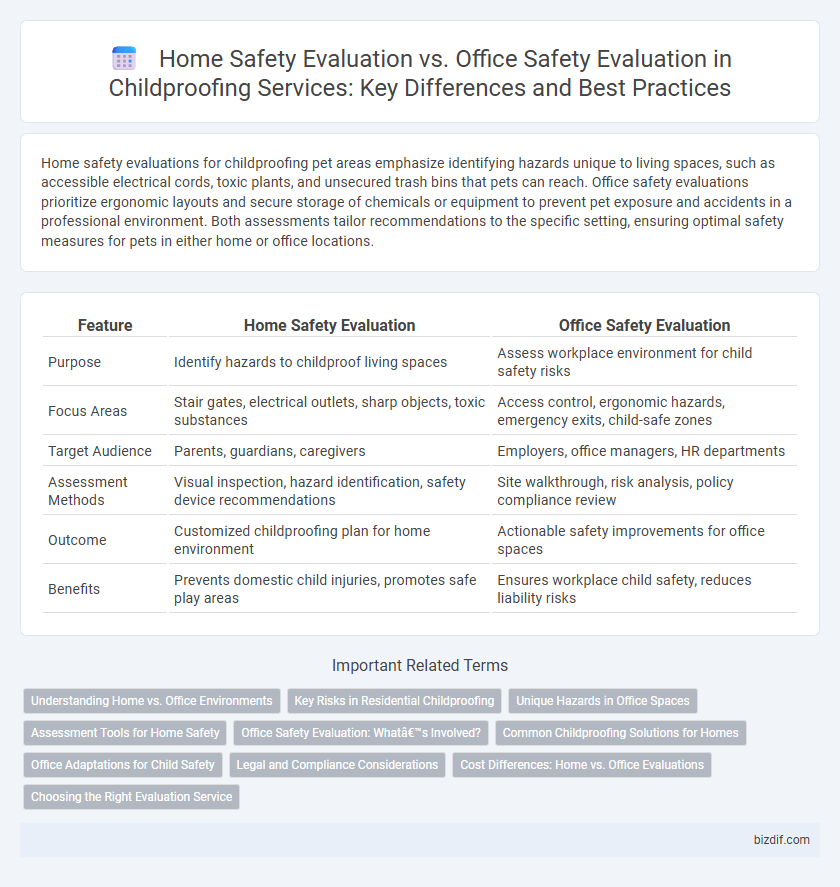Home safety evaluations for childproofing pet areas emphasize identifying hazards unique to living spaces, such as accessible electrical cords, toxic plants, and unsecured trash bins that pets can reach. Office safety evaluations prioritize ergonomic layouts and secure storage of chemicals or equipment to prevent pet exposure and accidents in a professional environment. Both assessments tailor recommendations to the specific setting, ensuring optimal safety measures for pets in either home or office locations.
Table of Comparison
| Feature | Home Safety Evaluation | Office Safety Evaluation |
|---|---|---|
| Purpose | Identify hazards to childproof living spaces | Assess workplace environment for child safety risks |
| Focus Areas | Stair gates, electrical outlets, sharp objects, toxic substances | Access control, ergonomic hazards, emergency exits, child-safe zones |
| Target Audience | Parents, guardians, caregivers | Employers, office managers, HR departments |
| Assessment Methods | Visual inspection, hazard identification, safety device recommendations | Site walkthrough, risk analysis, policy compliance review |
| Outcome | Customized childproofing plan for home environment | Actionable safety improvements for office spaces |
| Benefits | Prevents domestic child injuries, promotes safe play areas | Ensures workplace child safety, reduces liability risks |
Understanding Home vs. Office Environments
Childproofing service involves distinct approaches for home safety evaluation compared to office safety evaluation, as residential environments typically contain hazards like stairs, furniture edges, and accessible chemicals requiring specialized protective measures. Office safety evaluations prioritize risks related to workspaces, such as electrical cords, ergonomic hazards, and emergency exits, focusing on compliance with occupational health standards. Understanding these differences ensures tailored solutions that effectively minimize injury risks in both home and office settings.
Key Risks in Residential Childproofing
Home safety evaluations identify key risks such as unsecured furniture, accessible sharp objects, toxic household chemicals, and unguarded electrical outlets critical in residential childproofing. Office safety evaluations focus primarily on ergonomic hazards, trip hazards, and emergency exits but rarely address dangers specific to young children. Prioritizing child-specific risks like choking hazards, stairs, and window locks in homes ensures a safer environment tailored to children's unique vulnerabilities.
Unique Hazards in Office Spaces
Home safety evaluations primarily address common domestic risks such as sharp edges, choking hazards, and electrical outlets, while office safety evaluations focus on unique hazards like exposed wiring, heavy office equipment, and ergonomic risks. Identifying tripping hazards from loose cables, ensuring secure storage of office supplies, and evaluating desk setups for proper posture are essential for preventing injuries in workplace environments. Tailored safety measures in office spaces reduce accident risks specific to professional settings, supporting a safer experience for employees and visitors alike.
Assessment Tools for Home Safety
Home safety evaluations utilize specialized assessment tools such as hazard checklists, child injury risk scoring systems, and interactive home environment simulations designed to identify potential dangers specific to domestic settings. These tools focus on common household risks like unsecured furniture, electrical outlet covers, and toxic substance storage, providing comprehensive data to tailor childproofing solutions effectively. Office safety evaluations, in contrast, often prioritize ergonomic and fire safety assessments, emphasizing different risk factors unrelated to the typical home environment hazards addressed by home-focused tools.
Office Safety Evaluation: What’s Involved?
Office safety evaluation involves a thorough assessment of workplace hazards, including electrical wiring, furniture stability, and emergency exits to prevent accidents and ensure compliance with safety regulations. The process includes identifying risks specific to office environments, such as ergonomic issues, fire hazards, and access control vulnerabilities. A detailed report with actionable recommendations helps businesses implement effective childproofing and employee safety measures.
Common Childproofing Solutions for Homes
Home safety evaluations typically emphasize identifying risks such as sharp edges, accessible toxic substances, electrical outlets, and stair hazards to implement childproofing solutions like outlet covers, cabinet locks, and corner guards. Office safety evaluations focus more on ergonomic setups, secure storage of office supplies, and limiting access to potentially dangerous equipment, but common childproofing elements like securing cords and blocking off restricted areas also apply. Effective childproofing in homes prioritizes creating a safe environment by minimizing choking hazards, installing safety gates, and ensuring furniture stability to prevent accidents.
Office Adaptations for Child Safety
Office safety evaluations prioritize ergonomic furniture, secure storage solutions, and child-safe technology setups to prevent accidents in workspaces frequented by children. Unlike home safety evaluations, office adaptations emphasize creating organized zones that minimize trip hazards and integrate childproofing measures without compromising professional functionality. Implementing soft-edge desk guards, cord management systems, and locked cabinets enhances office environments, ensuring comprehensive child safety in shared and professional settings.
Legal and Compliance Considerations
Home safety evaluations prioritize childproofing measures tailored to residential hazards, with a focus on domestic safety laws and consumer product regulations. Office safety evaluations emphasize adherence to workplace safety standards such as OSHA regulations, ensuring compliance with occupational health and safety laws to protect employees. Legal requirements differ significantly between home and office settings, impacting the scope and documentation needed for safety compliance and liability mitigation.
Cost Differences: Home vs. Office Evaluations
Home safety evaluations for childproofing typically cost less than office safety evaluations due to smaller spaces and fewer specialized hazards. Office safety evaluations often require comprehensive assessments of larger areas, including communal spaces, electrical setups, and ergonomic factors, increasing the overall expense. Pricing for home evaluations generally ranges between $100 and $300, while office evaluations can exceed $500 depending on the complexity and size of the workspace.
Choosing the Right Evaluation Service
Home safety evaluation focuses on identifying hazards unique to residential environments, such as securing furniture, covering electrical outlets, and childproofing staircases. Office safety evaluation targets workplace risks, including ergonomic assessments, emergency exit accessibility, and compliance with occupational safety standards. Choosing the right evaluation service depends on the specific environment where child safety measures are needed and the tailored recommendations each service provides.
Home safety evaluation vs Office safety evaluation Infographic

 bizdif.com
bizdif.com